Cost Accounting Practices in Different Industries
VerifiedAdded on 2020/05/28
|14
|2180
|191
AI Summary
This assignment delves into the application of cost accounting practices across diverse industries, focusing on healthcare and manufacturing. It examines how hospitals utilize cost allocation methods to determine patient treatment costs and generate bills. Similarly, it analyzes the cost management strategies employed by Redmond Gary, an Australian manufacturing firm, highlighting their labor hour allocation system for accurate cost determination and decision-making in pricing policies.
Contribute Materials
Your contribution can guide someone’s learning journey. Share your
documents today.

Running head: ACCOUNTING FOR MANAGERS
SOUTHERN CROSS UNIVERSITY
ASSIGNMENT COVER SHEET
For use with online submission of assignments
Please complete all of the following details and then make this sheet the first page of
each file of your assignment – do not send it as a separate document.
Your assignments must be submitted as either Word documents, text documents with .rtf
extension or as .pdf documents. If you wish to submit in any other file format please discuss
this with your lecturer well before the assignment submission date.
Student Name:
Student ID No.:
Unit Name:
Unit Code:
Tutor’s name:
SOUTHERN CROSS UNIVERSITY
ASSIGNMENT COVER SHEET
For use with online submission of assignments
Please complete all of the following details and then make this sheet the first page of
each file of your assignment – do not send it as a separate document.
Your assignments must be submitted as either Word documents, text documents with .rtf
extension or as .pdf documents. If you wish to submit in any other file format please discuss
this with your lecturer well before the assignment submission date.
Student Name:
Student ID No.:
Unit Name:
Unit Code:
Tutor’s name:
Secure Best Marks with AI Grader
Need help grading? Try our AI Grader for instant feedback on your assignments.
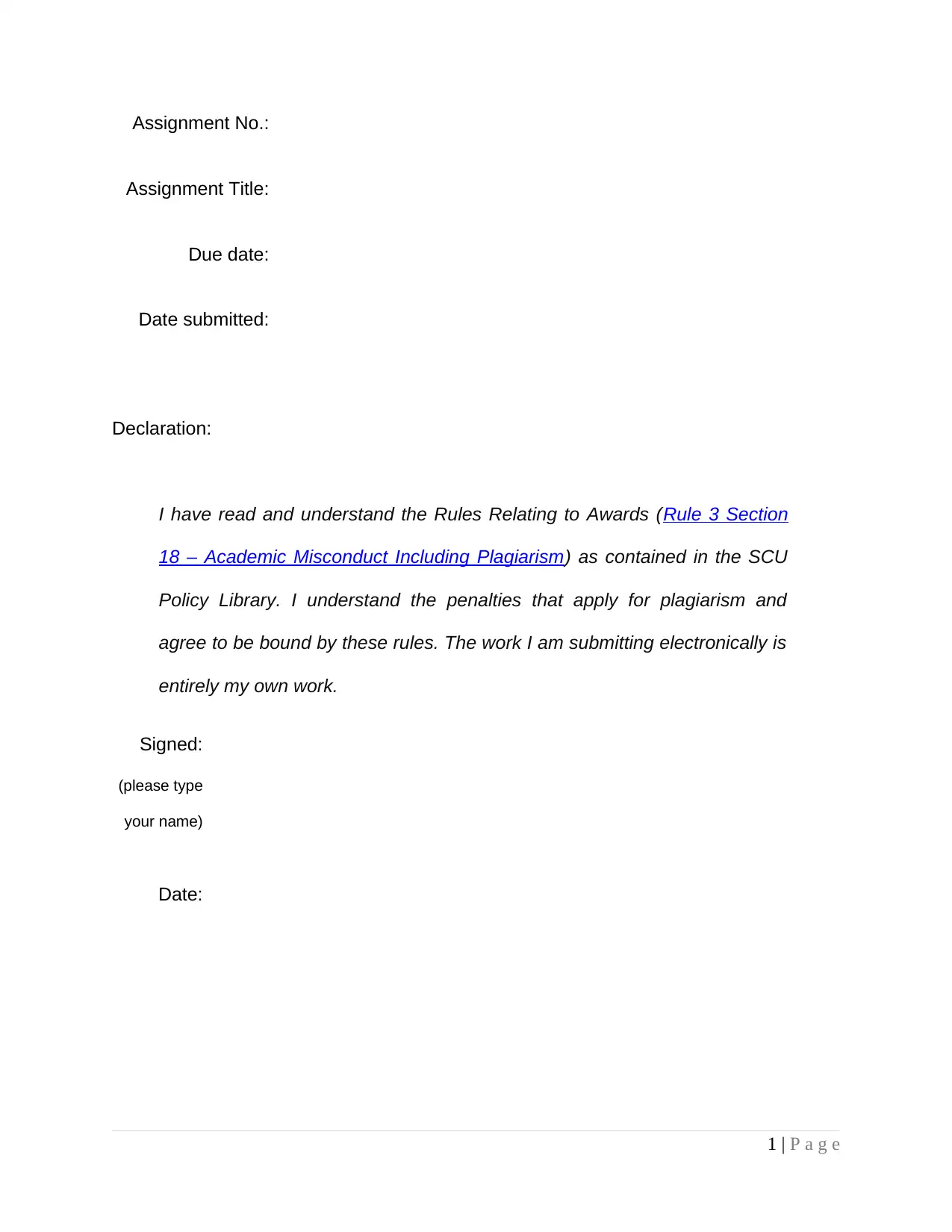
Assignment No.:
Assignment Title:
Due date:
Date submitted:
Declaration:
I have read and understand the Rules Relating to Awards (Rule 3 Section
18 – Academic Misconduct Including Plagiarism) as contained in the SCU
Policy Library. I understand the penalties that apply for plagiarism and
agree to be bound by these rules. The work I am submitting electronically is
entirely my own work.
Signed:
(please type
your name)
Date:
1 | P a g e
Assignment Title:
Due date:
Date submitted:
Declaration:
I have read and understand the Rules Relating to Awards (Rule 3 Section
18 – Academic Misconduct Including Plagiarism) as contained in the SCU
Policy Library. I understand the penalties that apply for plagiarism and
agree to be bound by these rules. The work I am submitting electronically is
entirely my own work.
Signed:
(please type
your name)
Date:
1 | P a g e
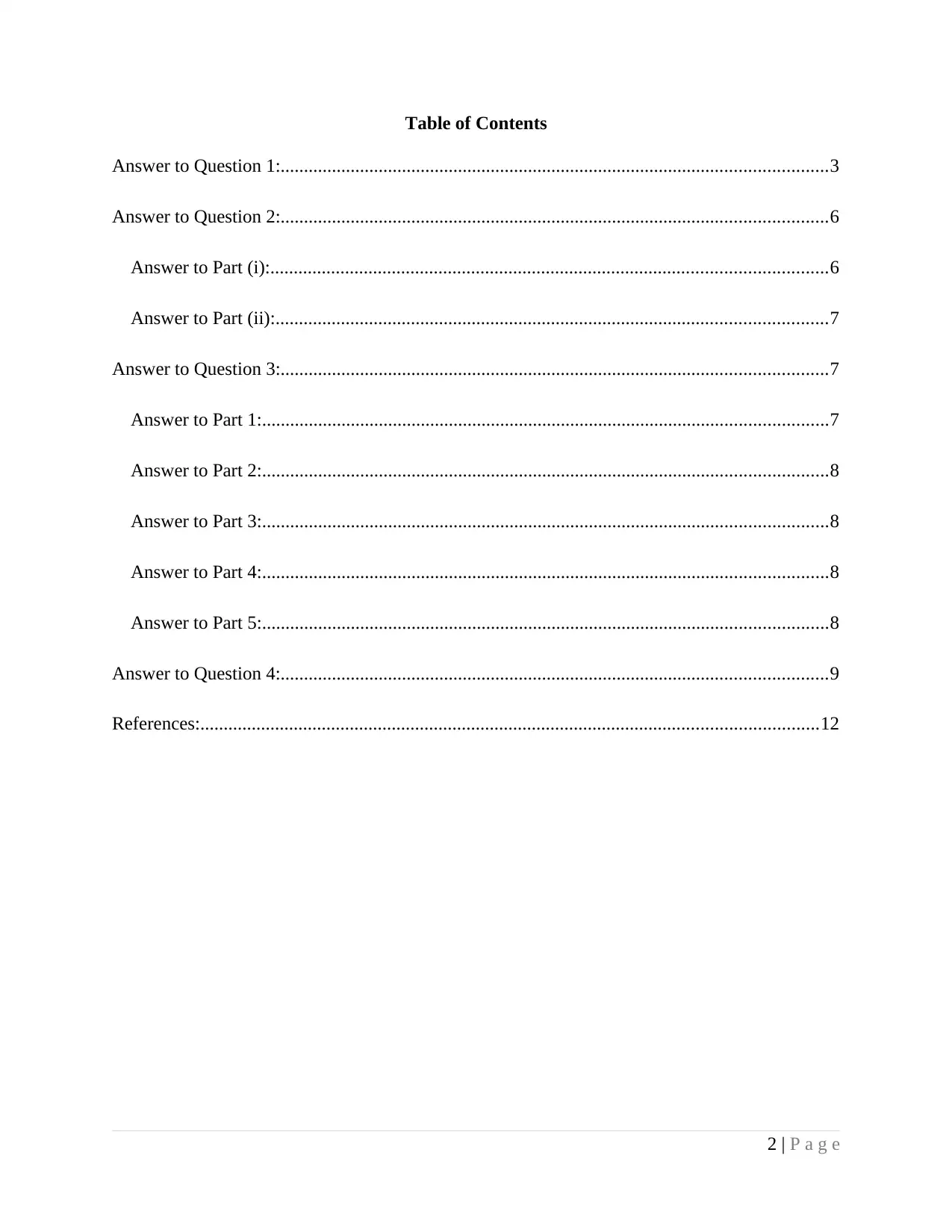
Table of Contents
Answer to Question 1:.....................................................................................................................3
Answer to Question 2:.....................................................................................................................6
Answer to Part (i):.......................................................................................................................6
Answer to Part (ii):......................................................................................................................7
Answer to Question 3:.....................................................................................................................7
Answer to Part 1:.........................................................................................................................7
Answer to Part 2:.........................................................................................................................8
Answer to Part 3:.........................................................................................................................8
Answer to Part 4:.........................................................................................................................8
Answer to Part 5:.........................................................................................................................8
Answer to Question 4:.....................................................................................................................9
References:....................................................................................................................................12
2 | P a g e
Answer to Question 1:.....................................................................................................................3
Answer to Question 2:.....................................................................................................................6
Answer to Part (i):.......................................................................................................................6
Answer to Part (ii):......................................................................................................................7
Answer to Question 3:.....................................................................................................................7
Answer to Part 1:.........................................................................................................................7
Answer to Part 2:.........................................................................................................................8
Answer to Part 3:.........................................................................................................................8
Answer to Part 4:.........................................................................................................................8
Answer to Part 5:.........................................................................................................................8
Answer to Question 4:.....................................................................................................................9
References:....................................................................................................................................12
2 | P a g e
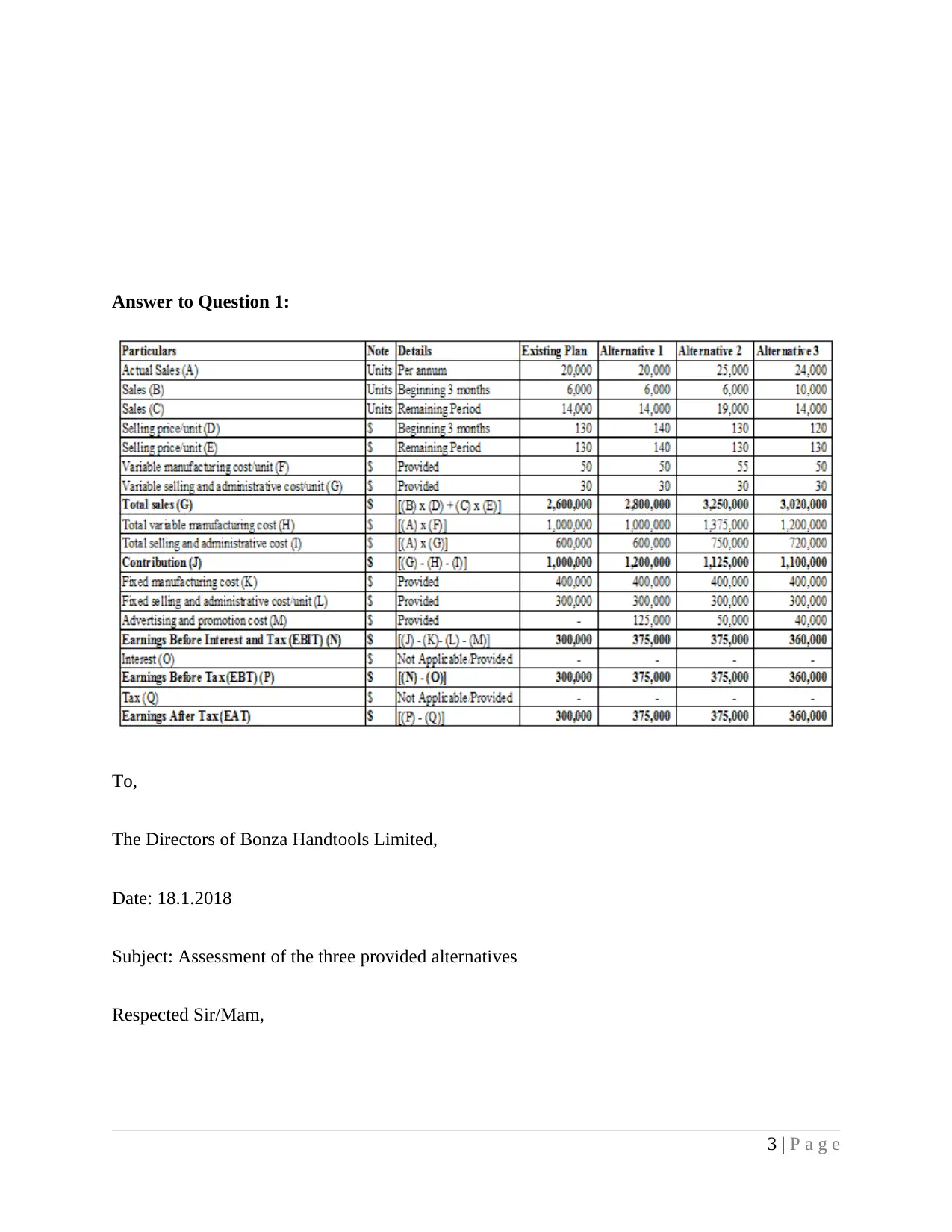
Answer to Question 1:
To,
The Directors of Bonza Handtools Limited,
Date: 18.1.2018
Subject: Assessment of the three provided alternatives
Respected Sir/Mam,
3 | P a g e
To,
The Directors of Bonza Handtools Limited,
Date: 18.1.2018
Subject: Assessment of the three provided alternatives
Respected Sir/Mam,
3 | P a g e
Secure Best Marks with AI Grader
Need help grading? Try our AI Grader for instant feedback on your assignments.
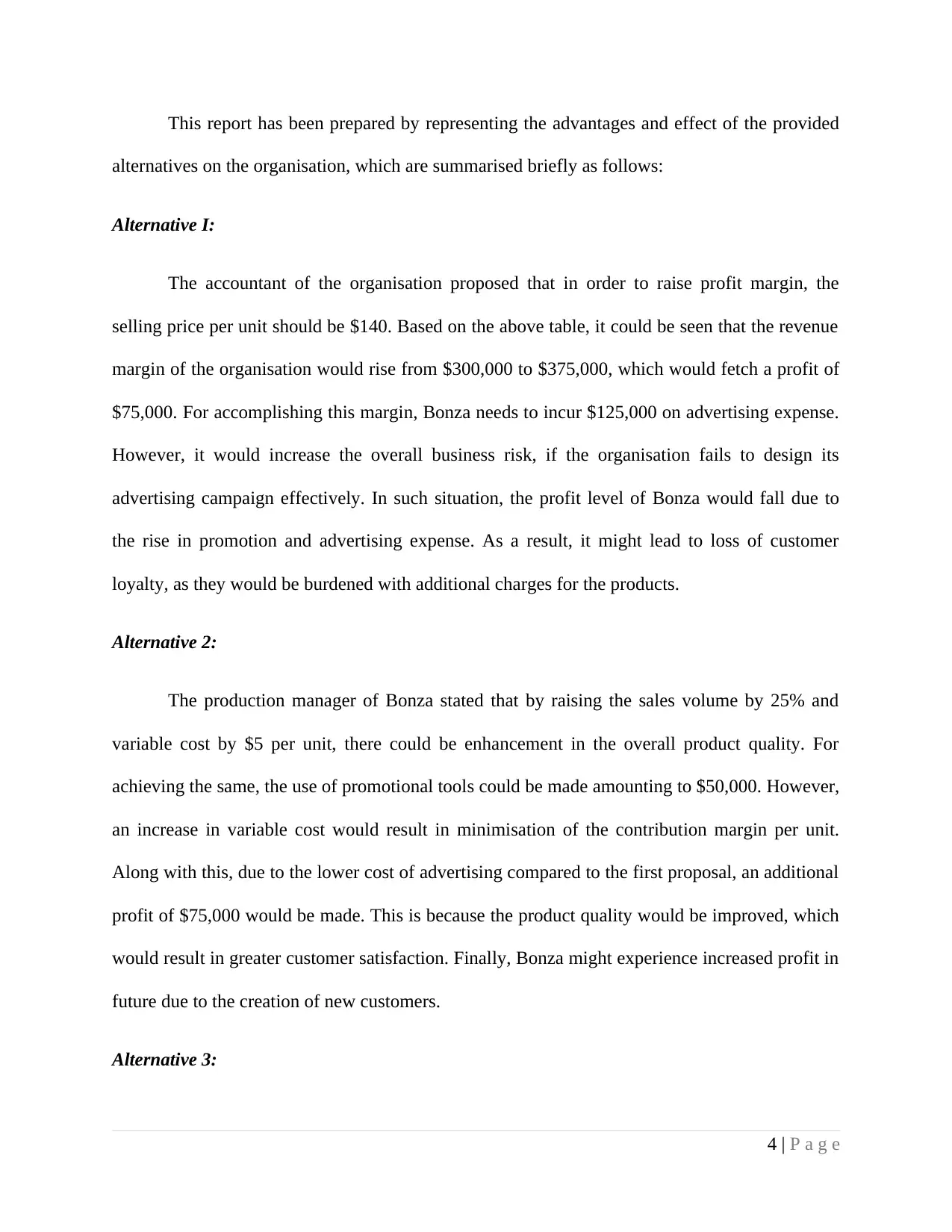
This report has been prepared by representing the advantages and effect of the provided
alternatives on the organisation, which are summarised briefly as follows:
Alternative I:
The accountant of the organisation proposed that in order to raise profit margin, the
selling price per unit should be $140. Based on the above table, it could be seen that the revenue
margin of the organisation would rise from $300,000 to $375,000, which would fetch a profit of
$75,000. For accomplishing this margin, Bonza needs to incur $125,000 on advertising expense.
However, it would increase the overall business risk, if the organisation fails to design its
advertising campaign effectively. In such situation, the profit level of Bonza would fall due to
the rise in promotion and advertising expense. As a result, it might lead to loss of customer
loyalty, as they would be burdened with additional charges for the products.
Alternative 2:
The production manager of Bonza stated that by raising the sales volume by 25% and
variable cost by $5 per unit, there could be enhancement in the overall product quality. For
achieving the same, the use of promotional tools could be made amounting to $50,000. However,
an increase in variable cost would result in minimisation of the contribution margin per unit.
Along with this, due to the lower cost of advertising compared to the first proposal, an additional
profit of $75,000 would be made. This is because the product quality would be improved, which
would result in greater customer satisfaction. Finally, Bonza might experience increased profit in
future due to the creation of new customers.
Alternative 3:
4 | P a g e
alternatives on the organisation, which are summarised briefly as follows:
Alternative I:
The accountant of the organisation proposed that in order to raise profit margin, the
selling price per unit should be $140. Based on the above table, it could be seen that the revenue
margin of the organisation would rise from $300,000 to $375,000, which would fetch a profit of
$75,000. For accomplishing this margin, Bonza needs to incur $125,000 on advertising expense.
However, it would increase the overall business risk, if the organisation fails to design its
advertising campaign effectively. In such situation, the profit level of Bonza would fall due to
the rise in promotion and advertising expense. As a result, it might lead to loss of customer
loyalty, as they would be burdened with additional charges for the products.
Alternative 2:
The production manager of Bonza stated that by raising the sales volume by 25% and
variable cost by $5 per unit, there could be enhancement in the overall product quality. For
achieving the same, the use of promotional tools could be made amounting to $50,000. However,
an increase in variable cost would result in minimisation of the contribution margin per unit.
Along with this, due to the lower cost of advertising compared to the first proposal, an additional
profit of $75,000 would be made. This is because the product quality would be improved, which
would result in greater customer satisfaction. Finally, Bonza might experience increased profit in
future due to the creation of new customers.
Alternative 3:
4 | P a g e
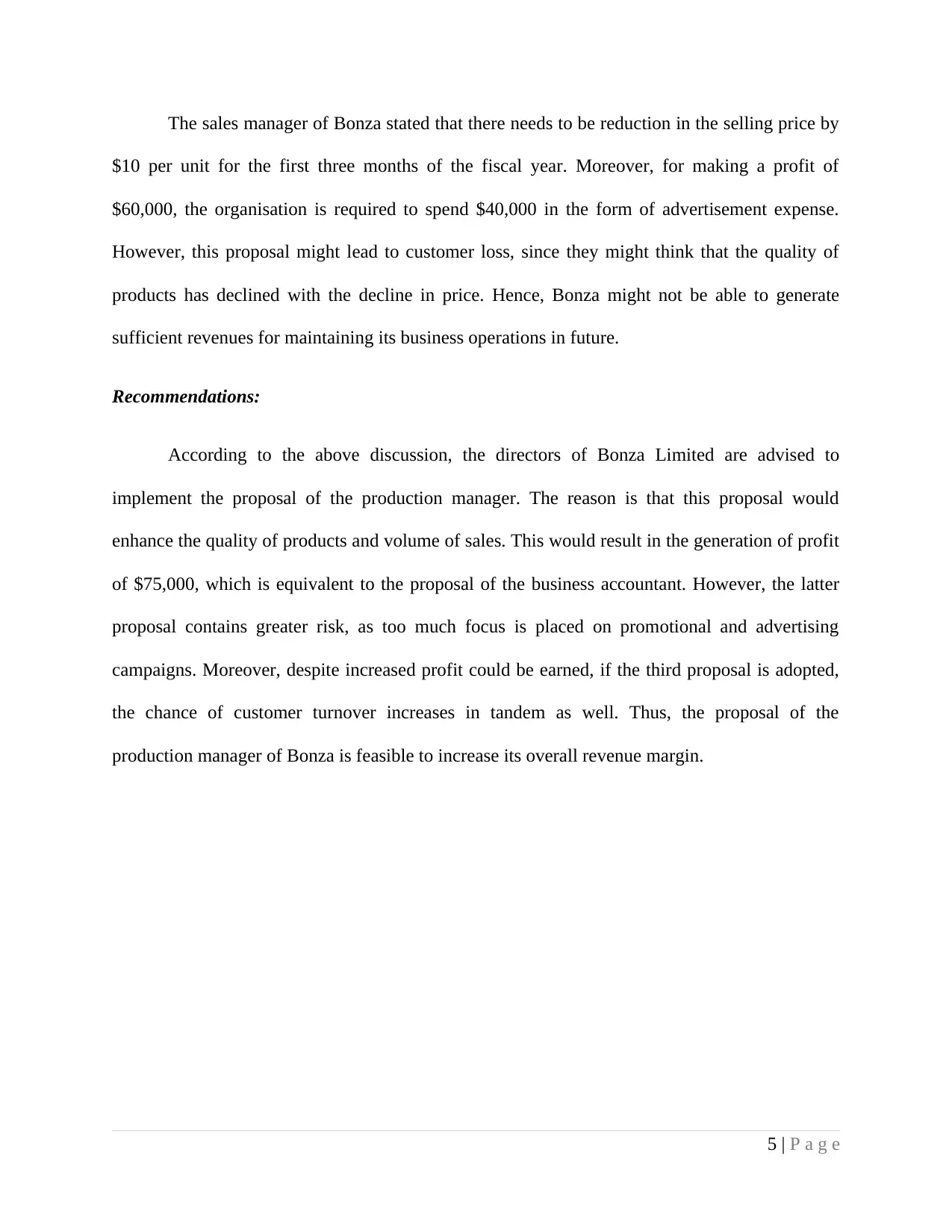
The sales manager of Bonza stated that there needs to be reduction in the selling price by
$10 per unit for the first three months of the fiscal year. Moreover, for making a profit of
$60,000, the organisation is required to spend $40,000 in the form of advertisement expense.
However, this proposal might lead to customer loss, since they might think that the quality of
products has declined with the decline in price. Hence, Bonza might not be able to generate
sufficient revenues for maintaining its business operations in future.
Recommendations:
According to the above discussion, the directors of Bonza Limited are advised to
implement the proposal of the production manager. The reason is that this proposal would
enhance the quality of products and volume of sales. This would result in the generation of profit
of $75,000, which is equivalent to the proposal of the business accountant. However, the latter
proposal contains greater risk, as too much focus is placed on promotional and advertising
campaigns. Moreover, despite increased profit could be earned, if the third proposal is adopted,
the chance of customer turnover increases in tandem as well. Thus, the proposal of the
production manager of Bonza is feasible to increase its overall revenue margin.
5 | P a g e
$10 per unit for the first three months of the fiscal year. Moreover, for making a profit of
$60,000, the organisation is required to spend $40,000 in the form of advertisement expense.
However, this proposal might lead to customer loss, since they might think that the quality of
products has declined with the decline in price. Hence, Bonza might not be able to generate
sufficient revenues for maintaining its business operations in future.
Recommendations:
According to the above discussion, the directors of Bonza Limited are advised to
implement the proposal of the production manager. The reason is that this proposal would
enhance the quality of products and volume of sales. This would result in the generation of profit
of $75,000, which is equivalent to the proposal of the business accountant. However, the latter
proposal contains greater risk, as too much focus is placed on promotional and advertising
campaigns. Moreover, despite increased profit could be earned, if the third proposal is adopted,
the chance of customer turnover increases in tandem as well. Thus, the proposal of the
production manager of Bonza is feasible to increase its overall revenue margin.
5 | P a g e
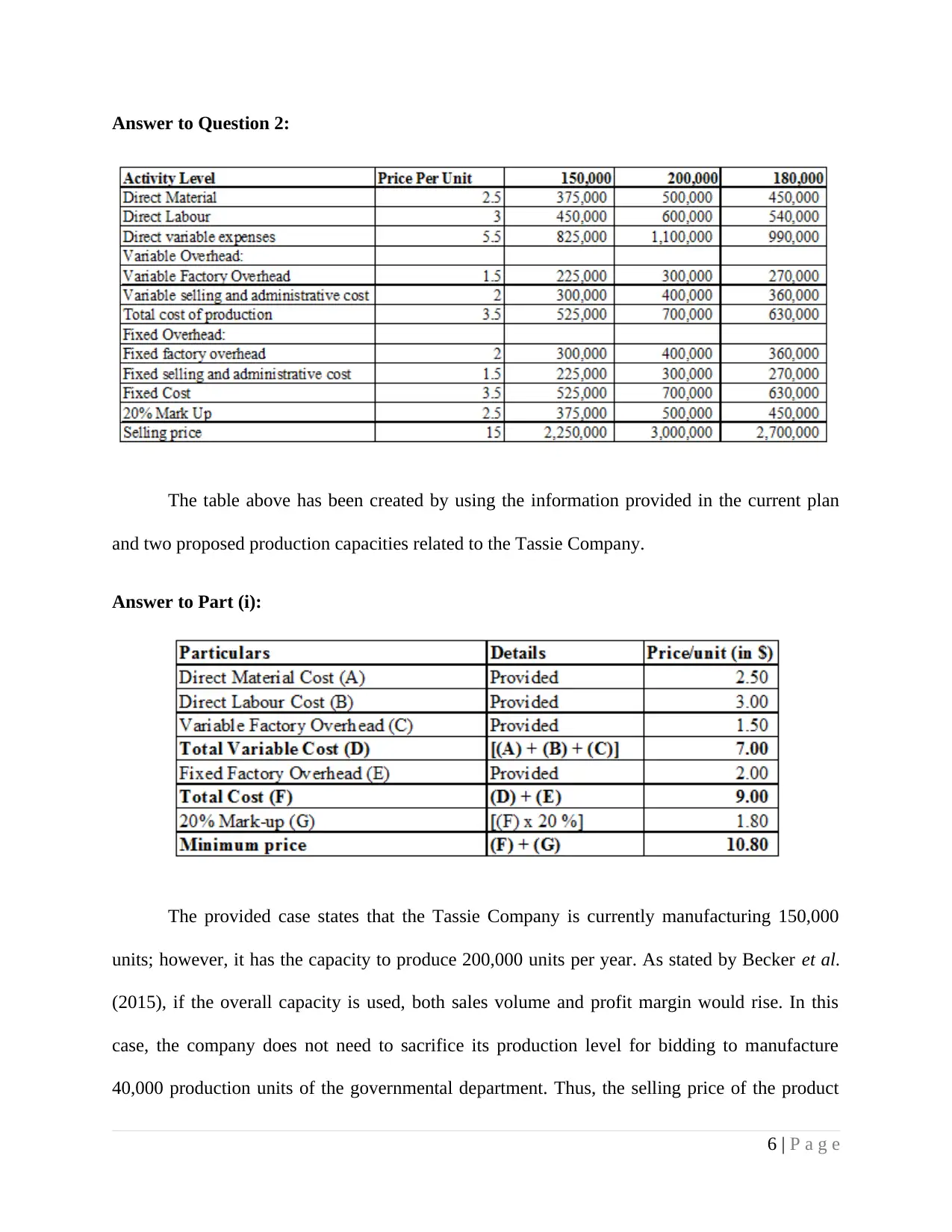
Answer to Question 2:
The table above has been created by using the information provided in the current plan
and two proposed production capacities related to the Tassie Company.
Answer to Part (i):
The provided case states that the Tassie Company is currently manufacturing 150,000
units; however, it has the capacity to produce 200,000 units per year. As stated by Becker et al.
(2015), if the overall capacity is used, both sales volume and profit margin would rise. In this
case, the company does not need to sacrifice its production level for bidding to manufacture
40,000 production units of the governmental department. Thus, the selling price of the product
6 | P a g e
The table above has been created by using the information provided in the current plan
and two proposed production capacities related to the Tassie Company.
Answer to Part (i):
The provided case states that the Tassie Company is currently manufacturing 150,000
units; however, it has the capacity to produce 200,000 units per year. As stated by Becker et al.
(2015), if the overall capacity is used, both sales volume and profit margin would rise. In this
case, the company does not need to sacrifice its production level for bidding to manufacture
40,000 production units of the governmental department. Thus, the selling price of the product
6 | P a g e
Paraphrase This Document
Need a fresh take? Get an instant paraphrase of this document with our AI Paraphraser
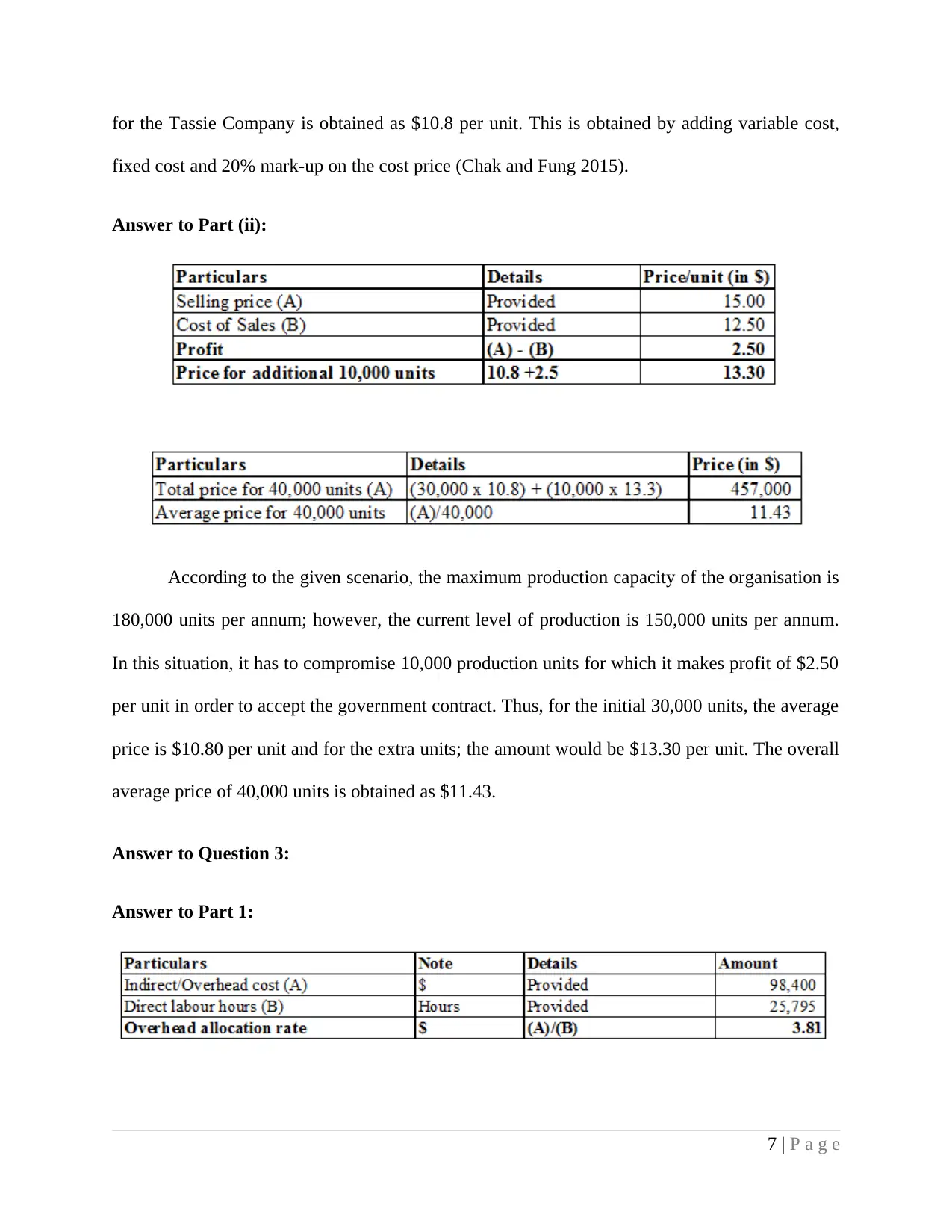
for the Tassie Company is obtained as $10.8 per unit. This is obtained by adding variable cost,
fixed cost and 20% mark-up on the cost price (Chak and Fung 2015).
Answer to Part (ii):
According to the given scenario, the maximum production capacity of the organisation is
180,000 units per annum; however, the current level of production is 150,000 units per annum.
In this situation, it has to compromise 10,000 production units for which it makes profit of $2.50
per unit in order to accept the government contract. Thus, for the initial 30,000 units, the average
price is $10.80 per unit and for the extra units; the amount would be $13.30 per unit. The overall
average price of 40,000 units is obtained as $11.43.
Answer to Question 3:
Answer to Part 1:
7 | P a g e
fixed cost and 20% mark-up on the cost price (Chak and Fung 2015).
Answer to Part (ii):
According to the given scenario, the maximum production capacity of the organisation is
180,000 units per annum; however, the current level of production is 150,000 units per annum.
In this situation, it has to compromise 10,000 production units for which it makes profit of $2.50
per unit in order to accept the government contract. Thus, for the initial 30,000 units, the average
price is $10.80 per unit and for the extra units; the amount would be $13.30 per unit. The overall
average price of 40,000 units is obtained as $11.43.
Answer to Question 3:
Answer to Part 1:
7 | P a g e
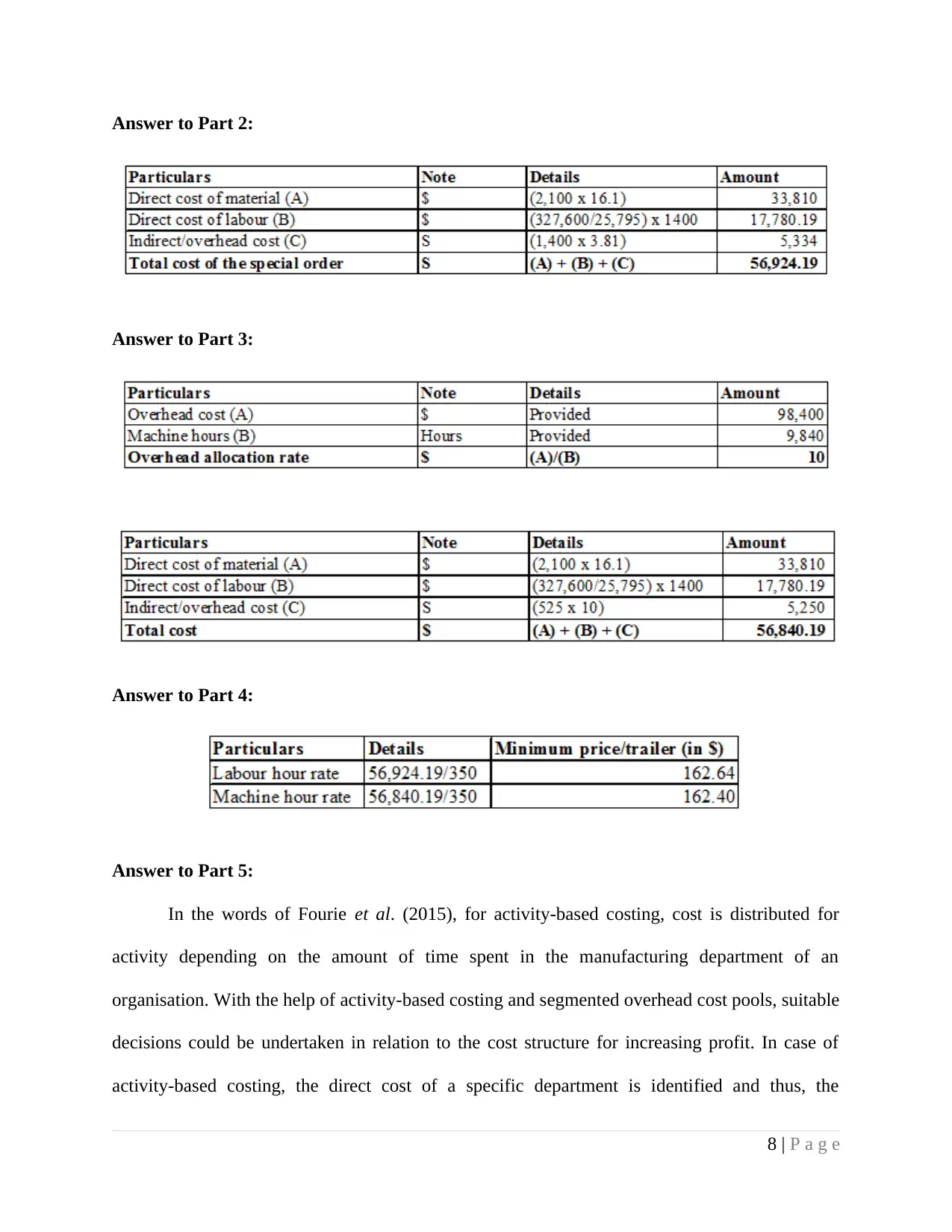
Answer to Part 2:
Answer to Part 3:
Answer to Part 4:
Answer to Part 5:
In the words of Fourie et al. (2015), for activity-based costing, cost is distributed for
activity depending on the amount of time spent in the manufacturing department of an
organisation. With the help of activity-based costing and segmented overhead cost pools, suitable
decisions could be undertaken in relation to the cost structure for increasing profit. In case of
activity-based costing, the direct cost of a specific department is identified and thus, the
8 | P a g e
Answer to Part 3:
Answer to Part 4:
Answer to Part 5:
In the words of Fourie et al. (2015), for activity-based costing, cost is distributed for
activity depending on the amount of time spent in the manufacturing department of an
organisation. With the help of activity-based costing and segmented overhead cost pools, suitable
decisions could be undertaken in relation to the cost structure for increasing profit. In case of
activity-based costing, the direct cost of a specific department is identified and thus, the
8 | P a g e
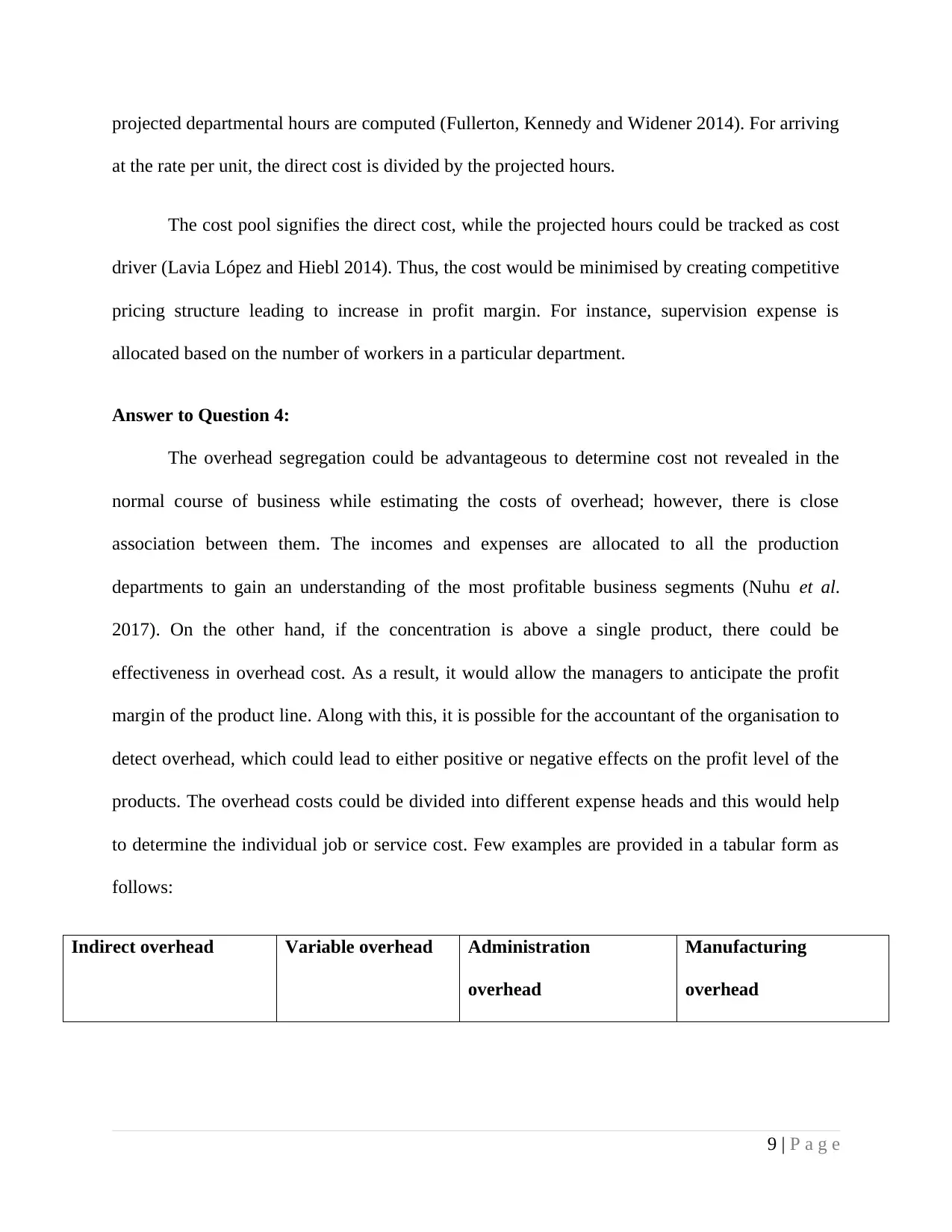
projected departmental hours are computed (Fullerton, Kennedy and Widener 2014). For arriving
at the rate per unit, the direct cost is divided by the projected hours.
The cost pool signifies the direct cost, while the projected hours could be tracked as cost
driver (Lavia López and Hiebl 2014). Thus, the cost would be minimised by creating competitive
pricing structure leading to increase in profit margin. For instance, supervision expense is
allocated based on the number of workers in a particular department.
Answer to Question 4:
The overhead segregation could be advantageous to determine cost not revealed in the
normal course of business while estimating the costs of overhead; however, there is close
association between them. The incomes and expenses are allocated to all the production
departments to gain an understanding of the most profitable business segments (Nuhu et al.
2017). On the other hand, if the concentration is above a single product, there could be
effectiveness in overhead cost. As a result, it would allow the managers to anticipate the profit
margin of the product line. Along with this, it is possible for the accountant of the organisation to
detect overhead, which could lead to either positive or negative effects on the profit level of the
products. The overhead costs could be divided into different expense heads and this would help
to determine the individual job or service cost. Few examples are provided in a tabular form as
follows:
Indirect overhead Variable overhead Administration
overhead
Manufacturing
overhead
9 | P a g e
at the rate per unit, the direct cost is divided by the projected hours.
The cost pool signifies the direct cost, while the projected hours could be tracked as cost
driver (Lavia López and Hiebl 2014). Thus, the cost would be minimised by creating competitive
pricing structure leading to increase in profit margin. For instance, supervision expense is
allocated based on the number of workers in a particular department.
Answer to Question 4:
The overhead segregation could be advantageous to determine cost not revealed in the
normal course of business while estimating the costs of overhead; however, there is close
association between them. The incomes and expenses are allocated to all the production
departments to gain an understanding of the most profitable business segments (Nuhu et al.
2017). On the other hand, if the concentration is above a single product, there could be
effectiveness in overhead cost. As a result, it would allow the managers to anticipate the profit
margin of the product line. Along with this, it is possible for the accountant of the organisation to
detect overhead, which could lead to either positive or negative effects on the profit level of the
products. The overhead costs could be divided into different expense heads and this would help
to determine the individual job or service cost. Few examples are provided in a tabular form as
follows:
Indirect overhead Variable overhead Administration
overhead
Manufacturing
overhead
9 | P a g e
Secure Best Marks with AI Grader
Need help grading? Try our AI Grader for instant feedback on your assignments.
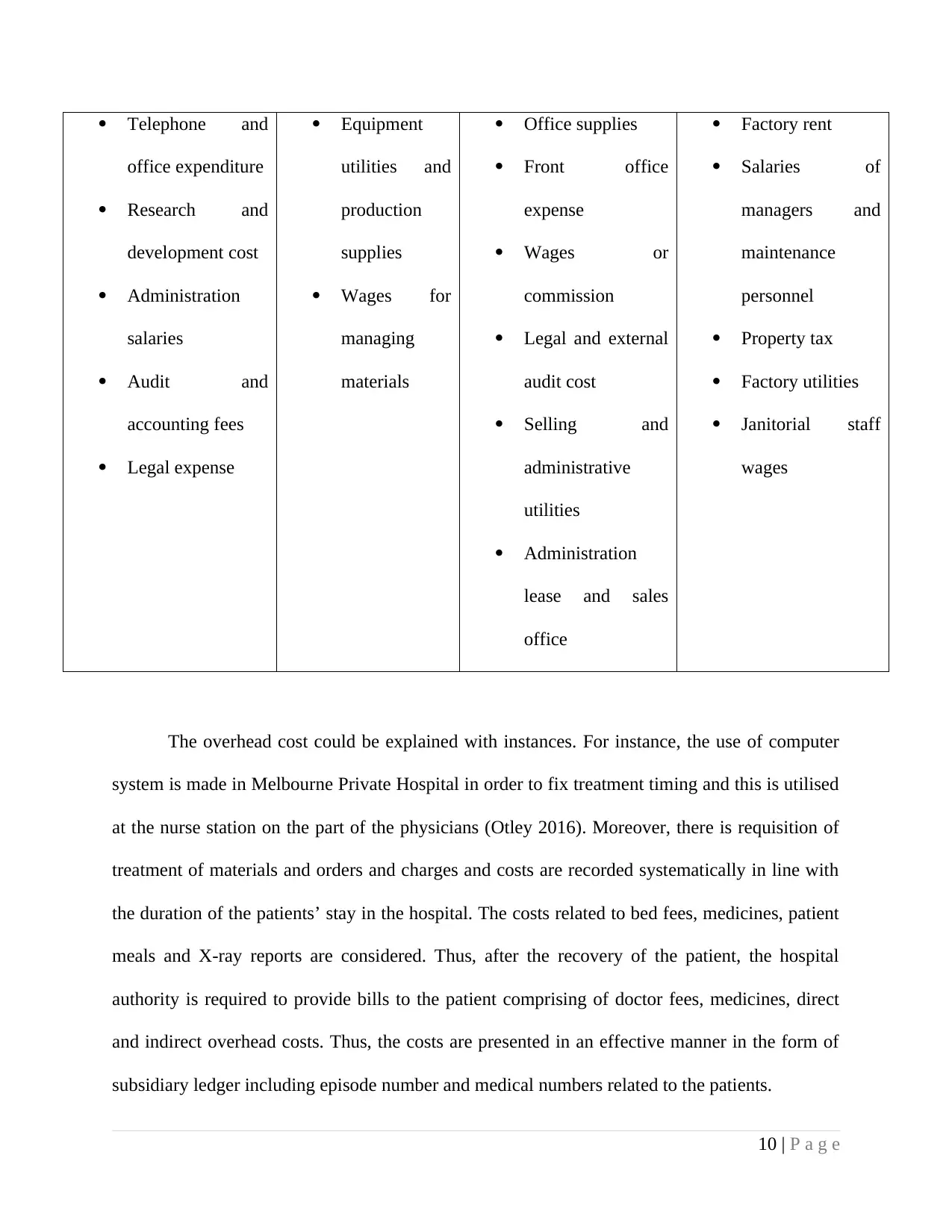
Telephone and
office expenditure
Research and
development cost
Administration
salaries
Audit and
accounting fees
Legal expense
Equipment
utilities and
production
supplies
Wages for
managing
materials
Office supplies
Front office
expense
Wages or
commission
Legal and external
audit cost
Selling and
administrative
utilities
Administration
lease and sales
office
Factory rent
Salaries of
managers and
maintenance
personnel
Property tax
Factory utilities
Janitorial staff
wages
The overhead cost could be explained with instances. For instance, the use of computer
system is made in Melbourne Private Hospital in order to fix treatment timing and this is utilised
at the nurse station on the part of the physicians (Otley 2016). Moreover, there is requisition of
treatment of materials and orders and charges and costs are recorded systematically in line with
the duration of the patients’ stay in the hospital. The costs related to bed fees, medicines, patient
meals and X-ray reports are considered. Thus, after the recovery of the patient, the hospital
authority is required to provide bills to the patient comprising of doctor fees, medicines, direct
and indirect overhead costs. Thus, the costs are presented in an effective manner in the form of
subsidiary ledger including episode number and medical numbers related to the patients.
10 | P a g e
office expenditure
Research and
development cost
Administration
salaries
Audit and
accounting fees
Legal expense
Equipment
utilities and
production
supplies
Wages for
managing
materials
Office supplies
Front office
expense
Wages or
commission
Legal and external
audit cost
Selling and
administrative
utilities
Administration
lease and sales
office
Factory rent
Salaries of
managers and
maintenance
personnel
Property tax
Factory utilities
Janitorial staff
wages
The overhead cost could be explained with instances. For instance, the use of computer
system is made in Melbourne Private Hospital in order to fix treatment timing and this is utilised
at the nurse station on the part of the physicians (Otley 2016). Moreover, there is requisition of
treatment of materials and orders and charges and costs are recorded systematically in line with
the duration of the patients’ stay in the hospital. The costs related to bed fees, medicines, patient
meals and X-ray reports are considered. Thus, after the recovery of the patient, the hospital
authority is required to provide bills to the patient comprising of doctor fees, medicines, direct
and indirect overhead costs. Thus, the costs are presented in an effective manner in the form of
subsidiary ledger including episode number and medical numbers related to the patients.
10 | P a g e
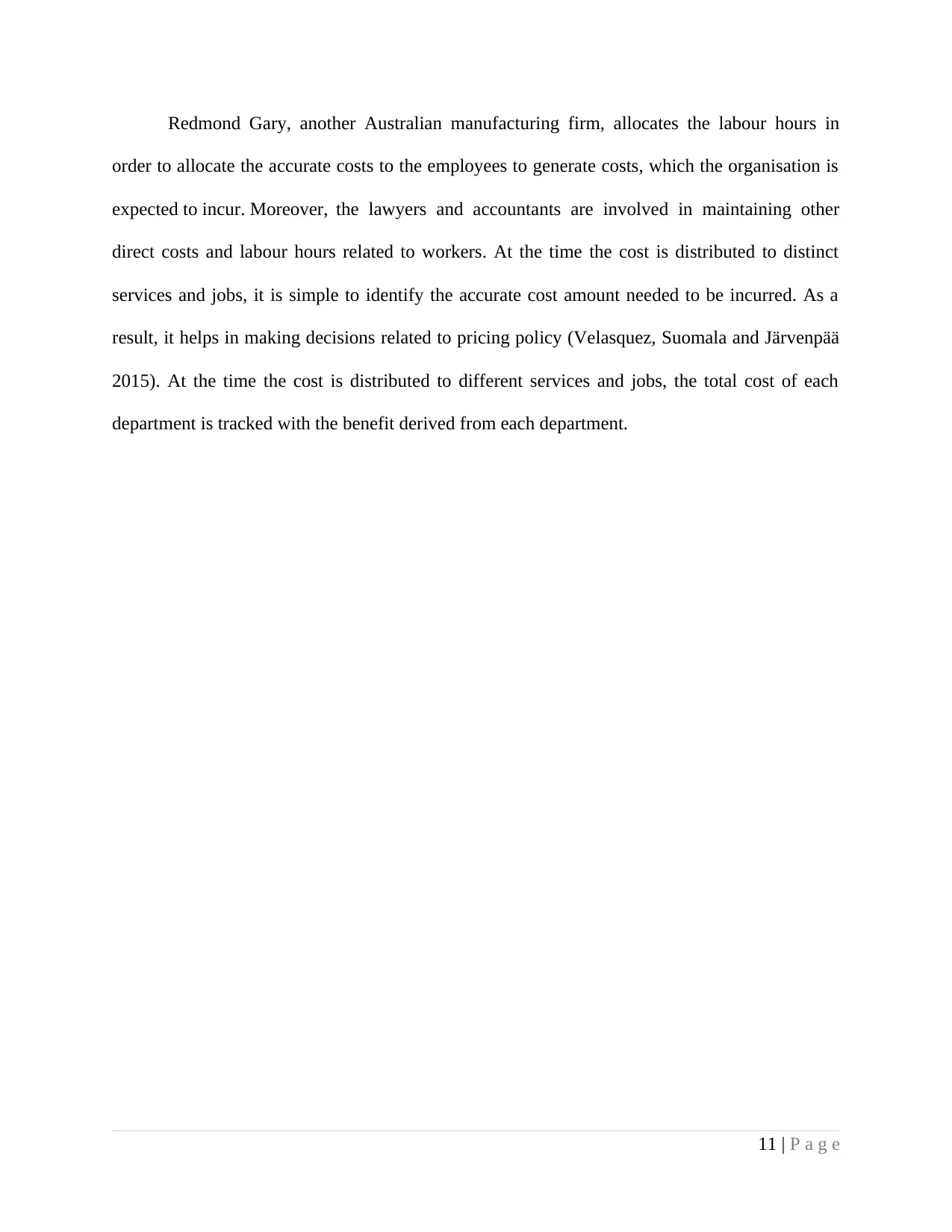
Redmond Gary, another Australian manufacturing firm, allocates the labour hours in
order to allocate the accurate costs to the employees to generate costs, which the organisation is
expected to incur. Moreover, the lawyers and accountants are involved in maintaining other
direct costs and labour hours related to workers. At the time the cost is distributed to distinct
services and jobs, it is simple to identify the accurate cost amount needed to be incurred. As a
result, it helps in making decisions related to pricing policy (Velasquez, Suomala and Järvenpää
2015). At the time the cost is distributed to different services and jobs, the total cost of each
department is tracked with the benefit derived from each department.
11 | P a g e
order to allocate the accurate costs to the employees to generate costs, which the organisation is
expected to incur. Moreover, the lawyers and accountants are involved in maintaining other
direct costs and labour hours related to workers. At the time the cost is distributed to distinct
services and jobs, it is simple to identify the accurate cost amount needed to be incurred. As a
result, it helps in making decisions related to pricing policy (Velasquez, Suomala and Järvenpää
2015). At the time the cost is distributed to different services and jobs, the total cost of each
department is tracked with the benefit derived from each department.
11 | P a g e
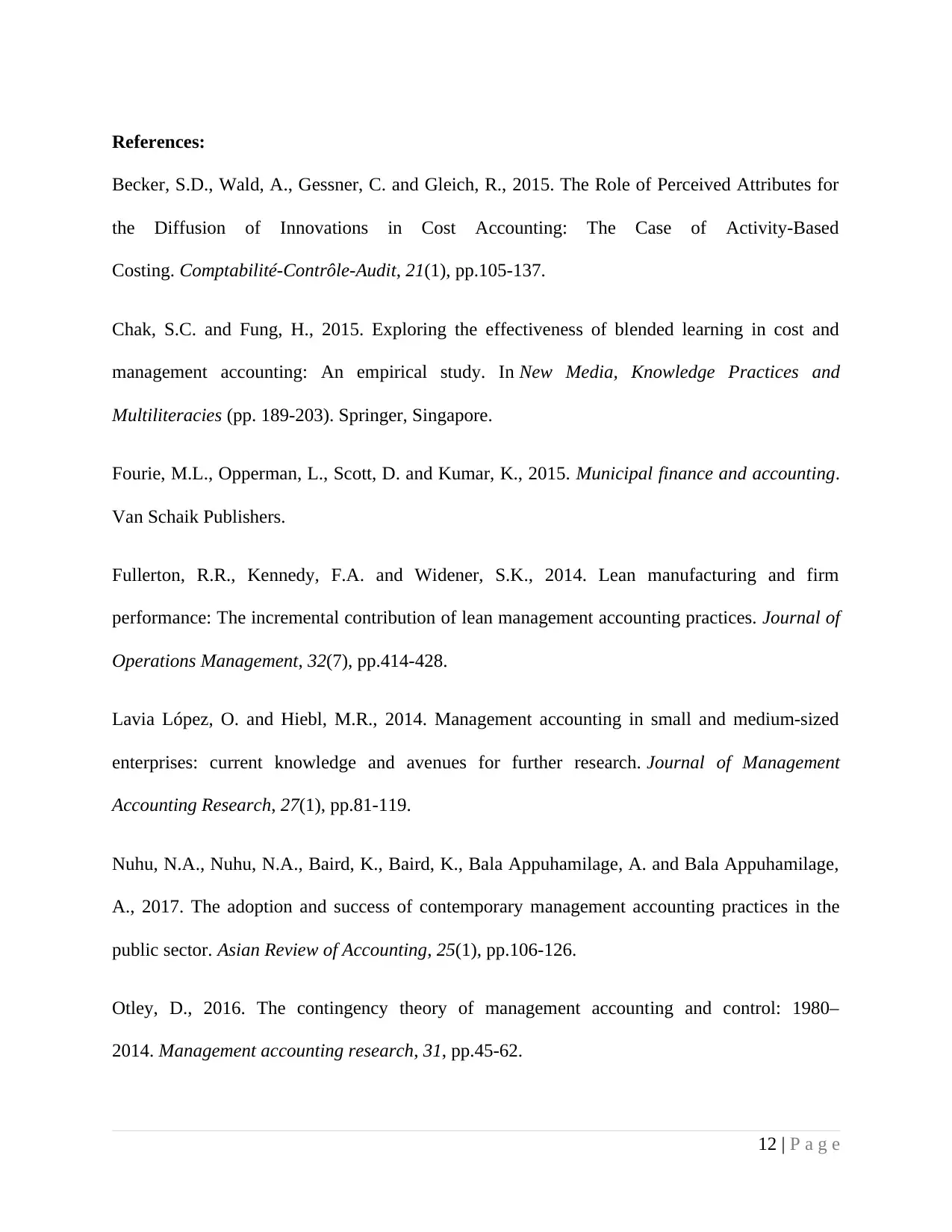
References:
Becker, S.D., Wald, A., Gessner, C. and Gleich, R., 2015. The Role of Perceived Attributes for
the Diffusion of Innovations in Cost Accounting: The Case of Activity-Based
Costing. Comptabilité-Contrôle-Audit, 21(1), pp.105-137.
Chak, S.C. and Fung, H., 2015. Exploring the effectiveness of blended learning in cost and
management accounting: An empirical study. In New Media, Knowledge Practices and
Multiliteracies (pp. 189-203). Springer, Singapore.
Fourie, M.L., Opperman, L., Scott, D. and Kumar, K., 2015. Municipal finance and accounting.
Van Schaik Publishers.
Fullerton, R.R., Kennedy, F.A. and Widener, S.K., 2014. Lean manufacturing and firm
performance: The incremental contribution of lean management accounting practices. Journal of
Operations Management, 32(7), pp.414-428.
Lavia López, O. and Hiebl, M.R., 2014. Management accounting in small and medium-sized
enterprises: current knowledge and avenues for further research. Journal of Management
Accounting Research, 27(1), pp.81-119.
Nuhu, N.A., Nuhu, N.A., Baird, K., Baird, K., Bala Appuhamilage, A. and Bala Appuhamilage,
A., 2017. The adoption and success of contemporary management accounting practices in the
public sector. Asian Review of Accounting, 25(1), pp.106-126.
Otley, D., 2016. The contingency theory of management accounting and control: 1980–
2014. Management accounting research, 31, pp.45-62.
12 | P a g e
Becker, S.D., Wald, A., Gessner, C. and Gleich, R., 2015. The Role of Perceived Attributes for
the Diffusion of Innovations in Cost Accounting: The Case of Activity-Based
Costing. Comptabilité-Contrôle-Audit, 21(1), pp.105-137.
Chak, S.C. and Fung, H., 2015. Exploring the effectiveness of blended learning in cost and
management accounting: An empirical study. In New Media, Knowledge Practices and
Multiliteracies (pp. 189-203). Springer, Singapore.
Fourie, M.L., Opperman, L., Scott, D. and Kumar, K., 2015. Municipal finance and accounting.
Van Schaik Publishers.
Fullerton, R.R., Kennedy, F.A. and Widener, S.K., 2014. Lean manufacturing and firm
performance: The incremental contribution of lean management accounting practices. Journal of
Operations Management, 32(7), pp.414-428.
Lavia López, O. and Hiebl, M.R., 2014. Management accounting in small and medium-sized
enterprises: current knowledge and avenues for further research. Journal of Management
Accounting Research, 27(1), pp.81-119.
Nuhu, N.A., Nuhu, N.A., Baird, K., Baird, K., Bala Appuhamilage, A. and Bala Appuhamilage,
A., 2017. The adoption and success of contemporary management accounting practices in the
public sector. Asian Review of Accounting, 25(1), pp.106-126.
Otley, D., 2016. The contingency theory of management accounting and control: 1980–
2014. Management accounting research, 31, pp.45-62.
12 | P a g e
Paraphrase This Document
Need a fresh take? Get an instant paraphrase of this document with our AI Paraphraser
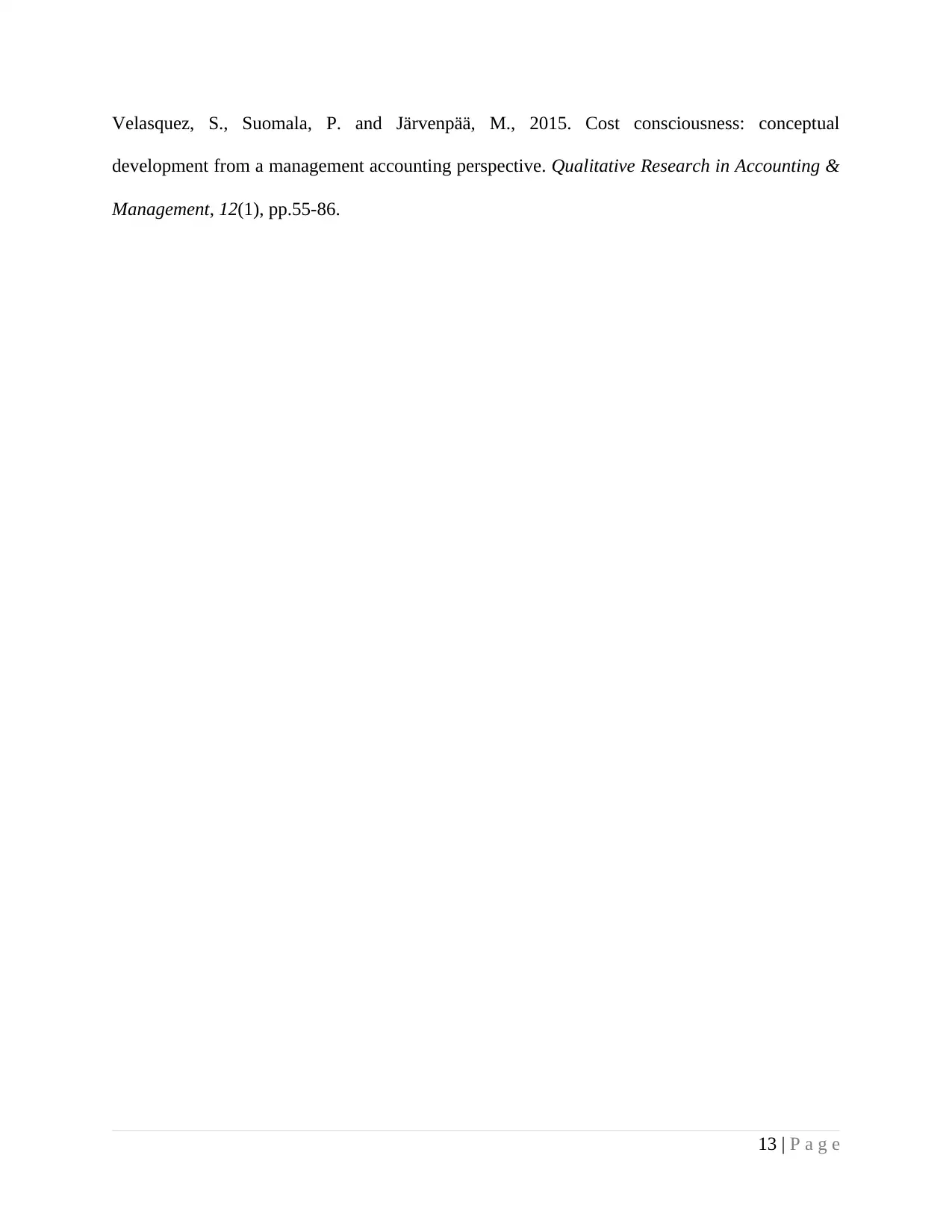
Velasquez, S., Suomala, P. and Järvenpää, M., 2015. Cost consciousness: conceptual
development from a management accounting perspective. Qualitative Research in Accounting &
Management, 12(1), pp.55-86.
13 | P a g e
development from a management accounting perspective. Qualitative Research in Accounting &
Management, 12(1), pp.55-86.
13 | P a g e
1 out of 14
Related Documents
Your All-in-One AI-Powered Toolkit for Academic Success.
+13062052269
info@desklib.com
Available 24*7 on WhatsApp / Email
![[object Object]](/_next/static/media/star-bottom.7253800d.svg)
Unlock your academic potential
© 2024 | Zucol Services PVT LTD | All rights reserved.





